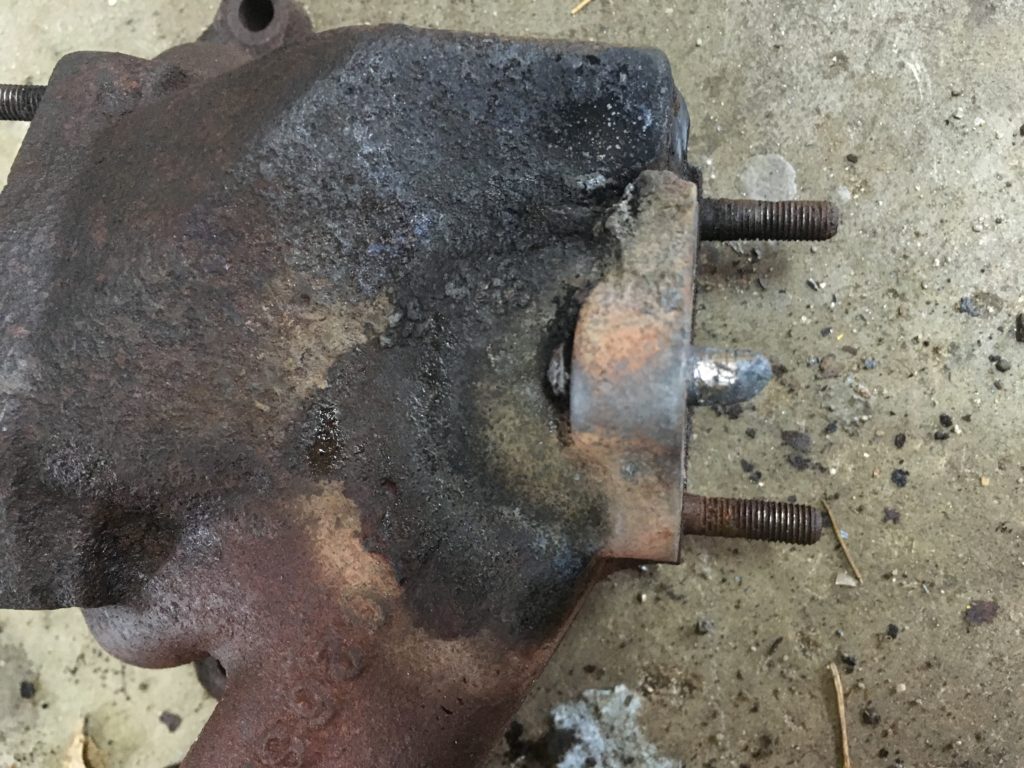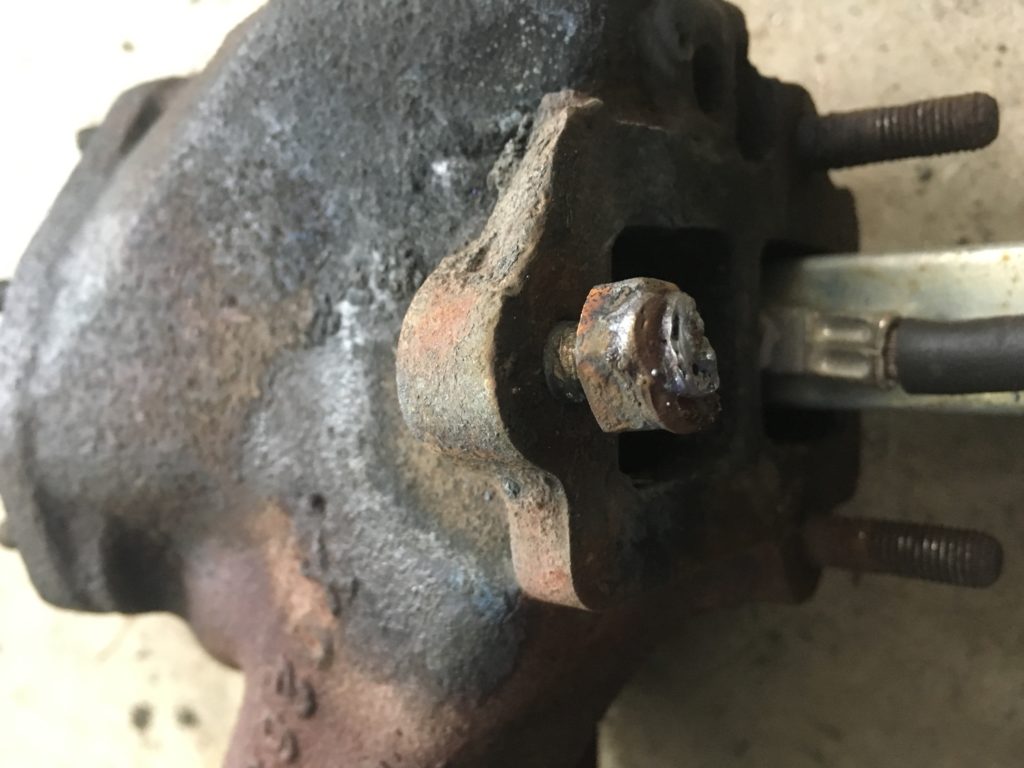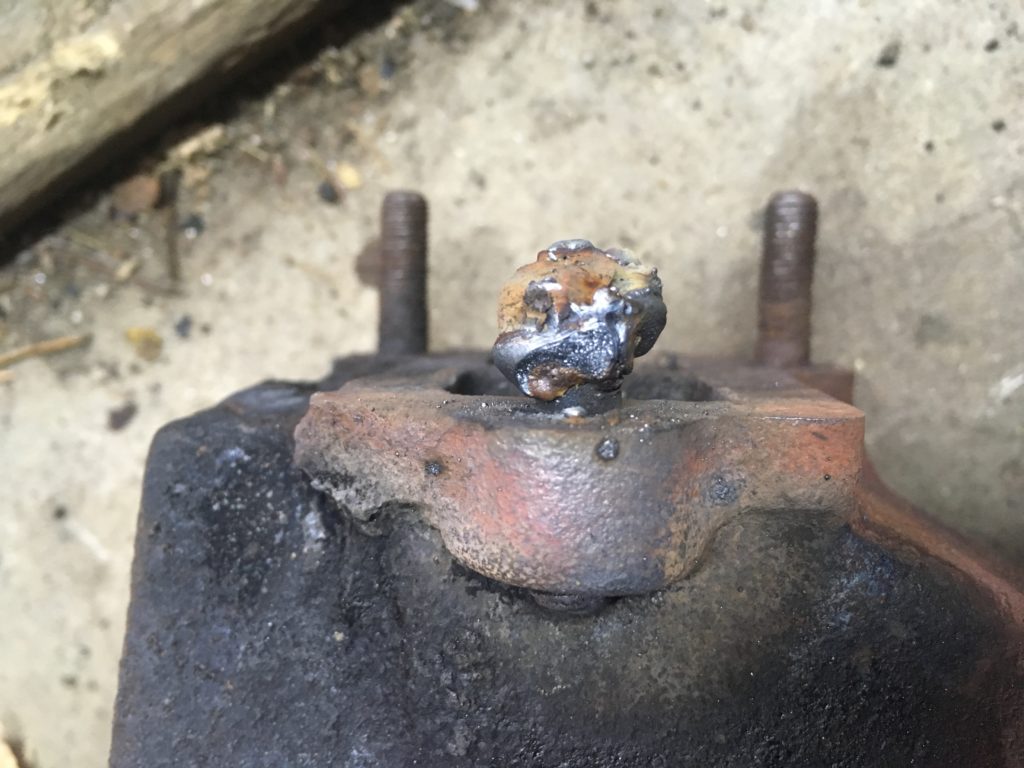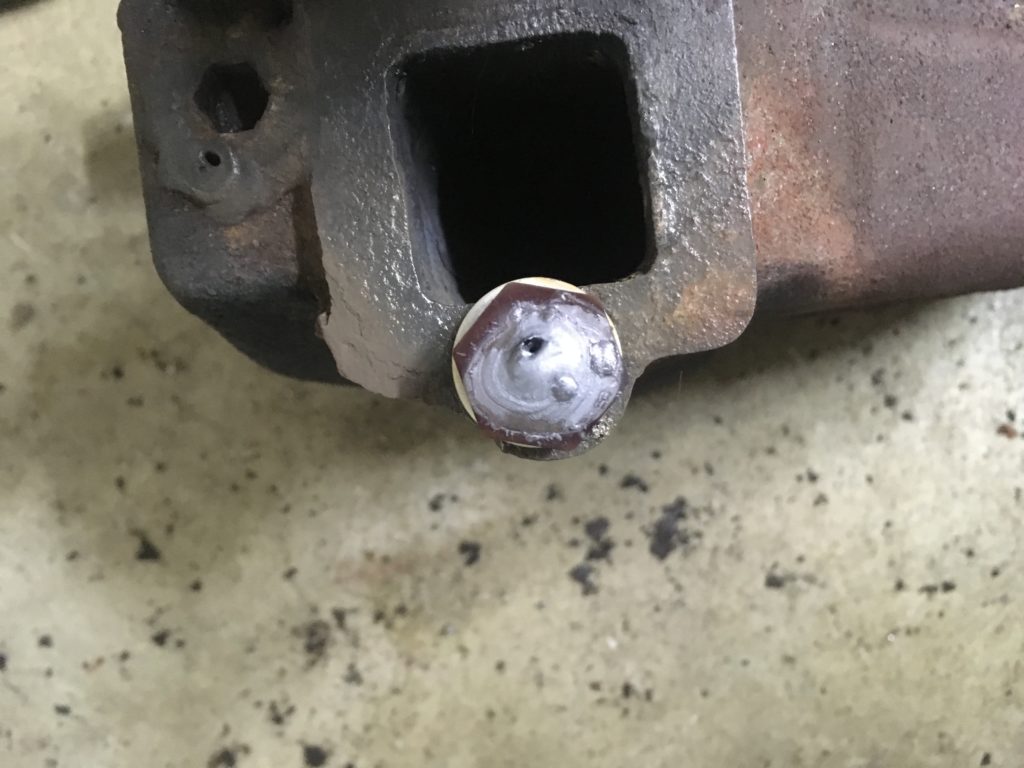There’s a chapter in my first book that details a number of techniques for removing stuck fasteners. Near the end of the chapter, I refer to welding a nut onto the end of a snapped-off stud. I didn’t give a lot of detail, because not owning a welder, I’d never actually done it.
But as I wrote in Roundel magazine a few months back, last summer I took the plunge and bought a used Millermatic 141 wire-feed mig welder. While I was certainly aware of the stuckness-related application, I thought that I’d soon be using it to patch the grapefruit-sized hole in Bertha’s floor pan. However, that didn’t happen; the welder just sat unused for nine months in the garage. Some of this was due to time constraints from other projects (and the fact that, to fix the hole in Bertha’s floor properly, the transmission-support bracket and the pedal bucket really need to come out of the car), but mostly it was because I’m well aware that practice is required before doing anything with a welder on a body panel of a car, even an unseen floor pan of a ratty car.
I have a tendency to go either all-in or all-out with things, and with the welder, I went all-in when I bought it—but then I kind of shifted to all-out. I literally hadn’t ever even plugged it in. It just sat in the garage, intimidating me with its presence and potential learning curve.
Until last week.
As part of the resurrection of my long-stalled Lotus Europa project (again, all-in or all-out), I unearthed the exhaust manifold that I’d last seen 5-1/2 years ago, and was reminded that during its removal I’d snapped off one of the studs where the downpipe is attached. It had, fortunately, broken off well-proud of the flange surface, so there was lots of stud left for my stud extractor (sort of like a drill chuck) to bite on. I assumed that between the extractor and liberal doses of heat and wax, the stud would give it up, but surprisingly, it did not. Multiple attempts with the oxyacetylene torch, the extractor, and a good set of Vise Grips succeeded only in wearing the exposed part of the stud down even further.

My removal attempts just wore down the broken end of the stud.
I posted the above photo on Facebook, and our friend Paul Wegweiser, who has been my welding spirit animal, was immediately all over me. “Dude! You’ve got a welder! Man up! Weld a nut onto the end of that bad boy, twist it out, and be done with it!”
Despite the tongue-lashing, I thought, this is perfect. There’s almost no way a neophyte like me can damage a cast-iron exhaust manifold. It’s not a body panel that I can warp by welding with too much heat. And if I was unsuccessful in getting the stud out by welding a nut onto it, the next step would be to cut it off flush and drill it out anyway (the automotive version of wearing a hair shirt).
I had nothing to lose, so I had at it.
The stud was already good and clean from the twisting of the extractor. I wire-brushed part of the manifold to clear a spot for a good electrical connection to the welder’s clamp. I found a nut about the same size as the stud, force-threaded it on, turned on the welder, opened up the valve on the gas bottle to about 20 psi, verified that the wire feed still worked, donned my brand-new auto-darkening helmet and welding gloves, and let the sparks fly: my first weld!
It was terrible, but how good did it need to be? I was stoked.

It ain’t pretty, but it was my first.
Until I put a wrench on it and found that it had about as much adhesion as a piece of popcorn balanced on a golf tee.
Okay, I thought, crank up the amperage of the welder, increase the wire feed speed, and try again.
Same result.
On the third try, I welded the nut from both the front and the back. This time it stayed on the stud long enough to put some actual torque on the wrench, but then twisted off.

On my third attempt, the nut took a long swim in the ugly pond.
Clearly I was right not to try to patch any of Bertha’s holes with these nonexistent welding skills. I messaged Paul Wegweiser and asked him what I was doing wrong. “Call me,” he immediately responded.
We chatted a good bit about a number of things (mostly the blood-pressure-inducing aspects of the Lotus engine rebuild), but then came back around to the welding issue. “You know that everything has to be clean, right? Welding uses electrical contact to melt metal. Is the stud clean? Are you using a new nut?”
“Um… I couldn’t find one,” I sheepishly admitted.
“That could be your problem right there,” Paul said. “Also, use a bigger nut. You’re not soldering [which flows solder into small spaces], you’re welding. You need to join metal by melting it and filling the gap with new metal. A bigger nut will give you more space to fill with the melted metal from the wire-feed welder. Plus, once the bigger nut is on, it’ll let you apply more torque.” It all made sense.
I was concerned about accidentally welding the stud to the manifold, so I first put a washer over the stud. I then took a nice new 3/4″ nut, centered it as best as I could on the stud, and had at it. This time, the result was beautiful:

I want to frame this and hang it in the garage.
What’s more, when I put the wrench on the nut, out came the stud. Joy! The video can be seen here.
People write that the real utility of the welder for stuckness comes when a stud or bolt has snapped off not proud of the surface but inside the hole. I’ve read that the technique is to use a washer to create a boundary around the rim of the hole, weld into it until the melted metal reaches the washer, then weld a nut onto it, but I haven’t tried this yet.
Without heading way off on a tangent, the way that heat is used to combat stuckness is several-fold. On the one hand, metal expands when you heat it, so if you have a nut on a stud, you usually want to heat the nut to help loosen it from around the stud; and if you have a stud screwed into something, you generally want to heat the surrounding metal, not the stud. On the other hand, I think that regardless of which piece is expanding, heat (along with penetrating oil or wax) helps to break the bond of corrosion on the threads.
There’s a meme that shows a stuck bolt next to a blowtorch, with the title “Can’t be tight if it’s a liquid.” It’s funny, but misleading. I’ve only had one application where heating something to near the point of melting was actually helpful. Years back, when I was removing the Z3 M coupe’s exhaust, I’d snapped several of the studs where the headpipe attaches to the manifold. Those studs have little splines on the edges and are pressed in from the back of the manifold flange, so by getting them cherry-red and slightly pliant, you can just smack them with a hammer and a punch, and their malleability makes them release their death grip on the mating surface and out they pop. But in general, with threaded fasteners, heating them to the point of melting is likely to damage threads that you probably wish to preserve.
Finally, I’ve seen it written that part of the benefit of these weld-on-a-nut techniques is that the act of welding passes a massive electrical current through the metal, including the stuck fastener, and this current, along with the heat generated, helps break the bond of corrosion. That, along with the repeated heat cycling I’d already done with the torch, may explain why the stud gave up the ghost in short order once the nut was welded onto it.
It’d be hubris to say, “Bring it on,” but I am thrilled that I now have the welder as another tool to deal with stuckness issues.—Rob Siegel
Rob’s new book, Just Needs a Recharge: The Hack MechanicTM Guide to Vintage Air Conditioning, is available here on Amazon. His previous book Ran When Parked is available here. Or you can order personally inscribed copies of all of his books through Rob’s website: www.robsiegel.com.





















